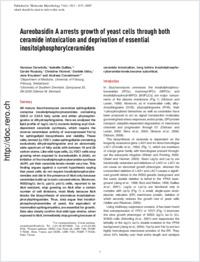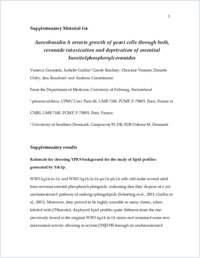Aureobasidin A arrests growth of yeast cells through both ceramide intoxication and deprivation of essential inositolphosphorylceramides
- Cerantola, Vanessa Department of Medicine, University of Fribourg, Switzerland
- Guillas, Isabelle Department of Medicine, University of Fribourg, Switzerland - UPMC Univ Paris 06, and CNRS, UMR 7180, Paris, France
- Roubaty, Carole Department of Medicine, University of Fribourg, Switzerland
- Vionnet, Christine Department of Medicine, University of Fribourg, Switzerland
- Uldry, Danièle Department of Medicine, University of Fribourg, Switzerland
- Knudsen, Jens University of Southern Denmark, Odense M, Denmark
- Conzelmann, Andreas Department of Medicine, University of Fribourg, Switzerland
-
04.02.2009
Published in:
- Molecular Microbiology. - 2009, vol. 71, no. 6, p. 1523 - 1537
English
All mature Saccharomyces cerevisiae sphingolipids comprise inositolphosphorylceramides containing C26:0 or C24:0 fatty acids and either phytosphingosine or dihydrosphingosine. Here we analysed the lipid profile of lag1Δlac1Δ mutants lacking acyl-CoA-dependent ceramide synthesis, which require the reverse ceramidase activity of overexpressed Ydc1p for sphingolipid biosynthesis and viability. These cells, termed 2Δ.YDC1, make sphingolipids containing exclusively dihydrosphingosine and an abnormally wide spectrum of fatty acids with between 18 and 26 carbon atoms. Like wild-type cells, 2Δ.YDC1 cells stop growing when exposed to Aureobasidin A (AbA), an inhibitor of the inositolphosphorylceramide synthase AUR1, yet their ceramide levels remain very low. This finding argues against a current hypothesis saying that yeast cells do not require inositolphosphorylceramides and die in the presence of AbA only because ceramides build up to toxic concentrations. Moreover, W303lag1Δlac1Δypc1Δydc1Δ cells, reported to be AbA resistant, stop growing on AbA after a certain number of cell divisions, most likely because AbA blocks the biosynthesis of anomalous inositolphosphorylsphingosides. Thus, data argue that inositolphosphorylceramides of yeast, the equivalent of mammalian sphingomyelins, are essential for growth. Data also clearly confirm that wild-type strains, when exposed to AbA, immediately stop growing because of ceramide intoxication, long before inositolphosphorylceramide levels become subcritical.
- Faculty
- Faculté des sciences et de médecine
- Department
- Département de Biologie
- Language
-
- English
- Classification
- Biological sciences
- License
-
License undefined
- Identifiers
-
- RERO DOC 12512
- DOI 10.1111/j.1365-2958.2009.06628.x
- Persistent URL
- https://folia.unifr.ch/unifr/documents/301409
Other files
Statistics
Document views: 104
File downloads:
- pdf: 241
- Supplementary material: 207

